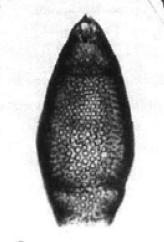|

|
|
Eucyrtidium aderces
Nigrini and Caulet, 1992
|
Description - Add description
Eucyrtidium aderces Nigrini and Caulet, n.sp. Plate 5, figures 1-4
Description: Shell surface smooth, four or five segments. Cephalis approximately spherical with a pitted surface. Apical horn very short, thorn like. Collar stricture indistinct. Thorax truncate conical with small subcircular pores arranged either in longitudinal rows or irregularly, 10-14 on a half equator. Lumbar stricture not constricted. The third segment may be elongate relative to other segments or may be divided into two truncate conical segments. If elongate, it is somewhat inflated, with small, circular pores in longitudinal rows on the proximal half and irregularly arranged, subcircular pores on the distal half. In some specimens (pl. 5, figs.3,4) there is a slight change in contour or bulge on the abdomen or an incomplete sagittal ring. If divided, the proximal part, which may now be considered as the abdomen or third segment, bears longitudinal rows of small circular pores and the distal part (now the fourth segment) has irregularly arranged small subcircular pores. Fourth (or fifth) segment constricted distally with irregular pores. Termination ragged.
Dimensions (based on 22 specimens): Diameter of cephalis 7-10µm. Length of thorax 10-25µm; length of abdomen 52-105, of fourth (fifth) segment 10-72µm. Maximum breadth of shell 65-72µm.
Distinguishing characters: This species is distinguished by its unusually long (when not divided) abdomen relative to the lengths of the other segments and bye its small pores, which are in longitudinal rows proximally and disorganized distally. The first three segment are conical in outline and the fourth segment is much narrower. When the abdomen is divided into two segments, the conical outline is maintained by the first four segments and the fifth segment is decidedly narrowe, the change in pore arrangement is also maintained, but between the third and fourth segments. Eucyrtidium aderces can be distinguished form E. indiensis Caulet by its mire conical outline, smaller, less regularly arranged pores and the sharp change in contour between the last two segments. It can be distinguished from some members of the E. teuscheri group by its smaller pores and distal constriction.
Range: This species ranges from the S. pentas Zone to the P. prismatium Zone. It is rare in the Oman material and absent form the Peru and Somali material.
Type: Holotype, ODP 721B-10X-cc, O46/4, MNHN (Paris) No. F61412; Paratype, ODP 721A-7H-cc, K42/3, MNHN (Paris) No. F61413.
Etymology: aderces = unexpected, unseen (Greek)
Remarks: The division of the third segment in this species is sometimes incomplete. Hence a specimen may appear to have four segments in one view, but from an opposite view it will appear to have five (see pl.5, figs. 3,4). We believe that this species thus demonstrates that the number of segments, at least in this genus, is taxonomically unimportant. | | Nigrini and Caulet 1992 |
|
|
 |

|